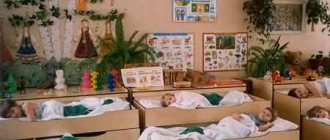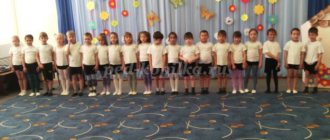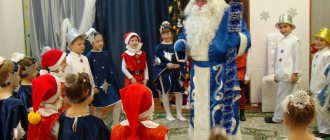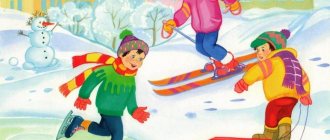Preview:
Reading fiction
Compiled by teacher: Motasova N. G.
Telling a Russian folk tale
Goal: To teach children to perceive the figurative content of the work; consolidate knowledge about the genre, compositional, linguistic features of the Russian fairy tale, continue to develop a poetic ear: the ability to hear and highlight expressive means in the text; bring children to awareness and understanding of figurative expressions.
Ushakova page 156
Conversation about A.S. Pushkin
Goal: To tell children about the great Russian poet; evoke a feeling of joy from the perception of his poems and a desire to hear other works of the poet.
V.V. Gerbova page 25
Memorizing a poem by A.S. Pushkin “The sky was already breathing in autumn.”
Goal: To teach children to expressively read a poem by heart, conveying intonation the sadness of autumn nature, to feel, understand and reproduce the imagery of the poem’s language; expand ideas about the landscape lyrics of A. S. Pushkin
Ushakova page 168
Reading stories about autumn, looking at illustrations.
“What are you sad about in autumn?”
Goal: To consolidate children’s knowledge about changes in autumn nature, to evoke admiration for the colors of autumn nature in the process of looking at illustrations and listening to artistic texts, the desire to express their impressions in figurative words, and to develop a poetic ear.
Ushakova page 158
Memorizing the poem “Autumn” by E. Trutneva.
Ushakova page 161
Telling the Ukrainian fairy tale "The Lame Duck"
Goal: To introduce the Ukrainian fairy tale, to bring to awareness of the artistic images of the fairy tale.
Ushakova page 169
Reading the fairy tale by D. Mamin - Sibiryak
"About the hare - long ears."
Goal: To form a holistic perception of a literary text in the unity of content and artistic form; consolidate children's knowledge about the features of different literary genres; Exercise children in the selection of comparisons, synonyms, antonyms, and cultivate a desire for accurate word usage.
Ushakova page 166
Introduction to a new genre - fable.
Reading the fable by I. A. Krylov “The Dragonfly and the Ant.”
Goal: To introduce children to the fable and its genre features; lead to an understanding of the allegory of a fable, an idea; to cultivate a feeling for the figurative structure of the fable’s language, to understand the meaning of proverbs about work, to connect the meaning of a proverb with a specific situation.
Source
Table: lesson notes by K. V. Tovmasyan on the topic “Honesty in L. N. Tolstoy’s fairy tale “The Bone””
| GCD stage | Contents of the stage |
| Goal and tasks | Develop an idea of honesty.
|
| Equipment |
|
| Introductory part | Greetings and getting ready to work. - Good afternoon, good hour! I'm so glad to see you. They looked at each other and quietly everyone sat down. – How are you feeling? Game “Find the Bone” – Look at these pictures. Berries are shown here. Find a berry with a seed among them. Getting to know the portrait of the writer. - Look at this portrait. It depicts Lev Nikolaevich Tolstoy. This is a great Russian writer who gave us a lot of interesting stories, fairy tales, poems and even riddles. He loved children very much: he opened a school in Yasnaya Polyana (an estate in the Tula province), taught them according to the “ABC”, which he wrote himself. – Today we will discuss the story of L.N. Tolstoy's "Bone". Want to know what it's about and why it's called that? |
| Main part | The teacher reads the story. Questions for conversation: - What did mom buy? - How did Vanya behave? - Who noticed that the plum was gone? — Why did Vanya decide to eat a plum? - Why didn’t he confess? - Why was dad worried? - What should Vanya have done? Physical education lesson The teacher reads a poem to the children and gives instructions on movements:
— They say: “Everything secret becomes clear sooner and later.” Do you agree with this? Give an example from the story “Bone”. - Tell me, is it necessary to hide something and be dishonest if the truth is found out anyway? Vocabulary work. — In the story there was an expression “blushed like a lobster.” Look at the illustrations for the fairy tale. Do you understand what it means? How else could you describe it? - What does the word “considered” mean? What is the upper room? |
| Final part | - What is the name of the story that we discussed today? - Why is it called that? - What would you do if you were Vanya? - You all worked very well today, well done. |
The teacher’s high-quality work in planning and during fiction reading classes is the key to the productive work of every child. Poems, riddles, didactic games - all this is necessary in the lesson, regardless of the chosen work. Classes in the preparatory group should be positive and exciting for all children, so tasks should be selected that are interesting and varied. This is the only way to instill in children a love of reading and literature.
Summary of a lesson on familiarization with fiction
Author: teacher Batmanova Natalya Igorevna.
MDOU "Kindergarten No. 55 of a combined type" Ukhta, Komi Republic.
Summary of a lesson on familiarization with fiction in a preparatory school group. Topic: “The fairy tale of K. D. Ushinsky “The pranks of the old woman-winter”
File: lesson notes
Summary of a lesson on familiarization with fiction in a preparatory school group.
Topic: “Fairy tale K. D. Ushinsky “The pranks of the old woman-winter”
Integration of educational areas: “Speech development”, “Cognitive development”, “Socio-communicative development”, “Physical development”
Goal: to systematize children’s ideas about winter as a season.
Program content:
• identify and summarize children’s knowledge about winter and its signs; • consolidate children's knowledge about weather conditions in winter, about the life and adaptation of birds and animals to winter conditions • develop oral speech, attention, thinking; • cultivate a caring attitude towards nature, the ability to see beauty.
Equipment: snowball; portrait of the author; paintings “Old Woman Winter”, “Winter in Our Lands”, “Winter in Warm Regions”; pictures with images of wintering and migratory birds, squares of different colors (white, grey, brown, orange), pictures with images of clothing items.
Progress of the lesson:
- Guys, please listen to the poem: There are deep snows all around, Wherever I look, a blizzard is blowing and swirling. Do you recognize winter? The rivers fell asleep under the ice. Frozen, motionless, the snowdrifts are burning like silver. Do you recognize winter? -By what signs did you recognize winter? (Snow has fallen, a blizzard is sweeping, the rivers have frozen and turned into ice.)
Game "Pick the sign"
(the teacher throws a snowball to the child and asks a question) -What kind of snow? (fluffy, soft, white, light) -Ice, what kind? (hard, transparent, smooth, thick) - What winter? (cold, frosty, windy) -We called adjectives associated with the signs of winter its weather. -One writer calls winter an old woman, that is, he talks about winter as about a person. Why do you think? (The picture “Old Woman Winter” is displayed)
Children: Winter is called an old woman because... (in winter there is a lot of snow, everything around is white like the gray hair of an old man).
This writer’s name is Konstantin Dmitrievich Ushinsky, and Vova will tell you about this writer (a child comes out with a portrait) Konstantin Dmitrievich Ushinsky is a famous Russian educator, teacher. But he taught children not only at school. He wrote many wonderful stories and fairy tales, after reading which children learned kindness, justice and other good qualities.
-So Ushinsky, in his fairy tale for children, calls winter not just an old woman, but a capricious and angry old woman, because old women are kind and caring. Do you want to know why? -Now I’m going to read you a fairy tale. D. Ushinsky “The pranks of the old woman-winter” (pranks are pranks, nasty things)
Reading a fairy tale.
-Guys, what words from the fairy tale do you not understand?
Vocabulary work:
Oak grove, forest; Eaves, zastrha - the lower edge of the roof, forming a canopy; Sleds; Fierce, angry, angry; The fields were powdered and snow fell on the fields.
-So why does the author call winter an angry, grumpy old woman? -What do we do on a walk, warming up from the cold, what winter fun do we know? -Let's build a snowman.
Physical exercise “Snowman”.
- The old woman-winter got angry, she decided to squeeze every breath from the world. -Guys, show me how angry winter is. -Winter blew cold, tore leaves from forests and oak groves and scattered them along the roads. -How did she have to blow to make the leaves fly away from the trees? Let's try. -Who did the old woman reach - winter first of all, at the very beginning? -Why didn’t she manage to freeze the birds?
Children: Some flew to warmer climes, while others stayed for the winter.
-What are the names of birds that fly away to warmer climes?
Children: Birds that fly to warmer regions are called “Migratory”.
-Right! What are the names of birds that stay for the winter?
Children: Birds that remain for the winter are called “winterers.”
-Well done! Now let’s play the game “Migratory - Wintering”. -You have two pictures in front of you. One shows winter in our area, and the other shows the warm southern region. And here are images of birds that need to escape the winter: fly alone to warmer climes, if they are migratory birds, and wintering birds will remain with us for the winter. —Are the animals afraid of winter? (The animals were not afraid: some have warm fur coats, others hid in deep holes; a squirrel in a hollow is gnawing nuts, a bear is sucking a paw in a den; a little bunny is jumping and warming himself, and horses, cows, and sheep have long been chewing ready-made hay in warm barns, They drink warm swill.)
-Let's play the game “Enchanted Animals” -The old woman-winter bewitched the animals and turned them into multi-colored pieces of ice. -You can disenchant them if you name who is white, orange, gray and brown)
Children are shown squares of different colors - corresponding to the color of the animals, the children guess (white - hare, gray - wolf, hedgehog, squirrel, orange - fox, brown - bear).
-Well done, you have disenchanted the animals! -What about the fish? Are they afraid of winter?
Children: No! They went to the deep end.
-Can fish talk?
Children: No! Pisces can't talk.
“I’ll also try to be a fish now, and you can guess from my lips what sounds I make.” (A, O, U, I) -What sounds are these, vowels or consonants? Why? -How do people escape from the old woman of winter?
Children: People dress warmly, rub their hands, face, ears. They heat the stove.
-And to stay completely warm, you need to wear winter clothes. (Pictures with images of clothes are laid out. Children choose pictures with winter clothes, naming them) - Well done! What winter activities were mentioned in the fairy tale?
Children: Skiing, sledding, skating, snowball fights, building a snow fort...
-Are children afraid of winter?
Children: No! They are happy and warm.
- Guys, what happened to the old woman in winter when she saw that she couldn’t take anything, neither birds, nor animals, nor people, nor small children.
Children: Winter cried.
-Why did she cry? -What do you think are the tears of winter? -Why are you crying? -The author calls winter an old woman, but what would you call it affectionately?
Reflection:
-What is the name of the fairy tale, author? -Who and what can you tell about the pranks of the old woman of winter?







